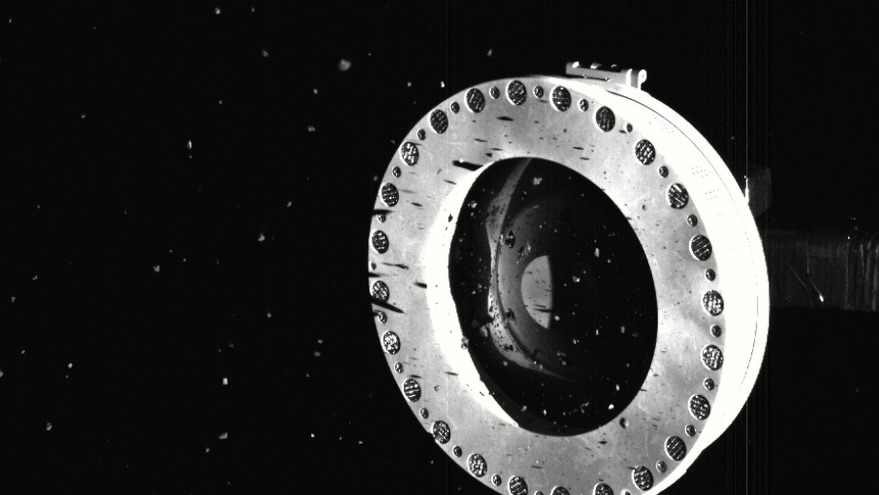WASHINGTON — NASA’s OSIRIS-REx spacecraft collected so much material from the surface of the asteroid Bennu that the lid of its sampling head is jammed open, causing material to leak out and changing the agency’s plans for the mission.
At a media briefing called by NASA on short notice Oct. 23, three days after the spacecraft touched down on the asteroid, officials said that images taken of the head of the sampling device, called the Touch-And-Go Sample Acquisition Mechanism (TAGSAM), showed material leaking out of the container from a gap in a Mylar diaphragm that is supposed to seal the bottom of the head.
“I am highly confident that TAGSAM was success, that it collected abundant mass: definitely evidence of hundreds of grams of material, and possibly more,” said Dante Lauretta, principal investigator for OSIRIS-REx at the University of Arizona. “My big concern now is that the particles are escaping because we were almost a victim of our own success.”
Those images show a cloud of particles outside of the TAGSAM, floating away from it at about one centimeter per second. He estimated that the material visible for those images had a mass of 5 to 10 grams. He added it is not likely a “steady state” mass loss since the head was moving around when those pictures were taken, helping particles escape through the gap in the diaphragm. Star tracker cameras on the spacecraft, which also detected the particles, saw much less after the head was “parked” on the side of the spacecraft.
The concern that more material might leak out of the sample head, though, has prompted NASA to change plans for the mission. Lauretta said that a maneuver planned for the weekend, where the spacecraft would be slowly spun up to measure the change in its moment of inertia and thus the mass of the sample material, has been canceled. Instead, planning is underway to stow the samples in a canister inside the spacecraft, where they will be sealed for return to Earth.
“Time is of the essence,” said Thomas Zurbuchen, NASA associate administrator for science. “I’ve made the decision to forego the sample mass measurement and ask the team to prepare immediately, and do the analysis to see if we’re ready, to stow.”
That stow maneuver was expected in early November, assuming that the sample collection effort did meet the goal of at least 60 grams of material. With it now clear that the spacecraft sampled far more, and with the risk of losing more material, that stowing process will begin as soon as Oct. 27, after finalizing procedures and securing time on the Deep Space Network.
Lauretta said it’s possible that they may lose tens of grams of additional material when stowing the sample. There is also a risk that material protruding from the bottom of the TAGSAM baseplate could interfere with the stowing process, but he said that the images showed none of the material there appeared to be big enough to pose a problem.
The TAGSAM collected so much material — Lauretta estimated there might be as much as two kilograms in the sample head — because the head plunged as deep as 48 centimeters below the surface during the touch-and-go maneuver. He noted that, during the mission’s development, the biggest uncertainty about the asteroid was the strength of its surface.
“We had to design for everything from a completely rigid surface, like running into a slab of concrete, down to what we called the ‘fairy castle’ structure with almost no resistance,” he said. “That was part of the challenge of the mission, coming up with a design that operated under all of those different circumstances, maintaining spacecraft safety, primarily. We’re definitely on the much softer end of that spectrum.”
Another change to mission plans is that the spacecraft did not perform a braking maneuver scheduled for Oct. 23 to slow the spacecraft’s departure from the asteroid. Lauretta said that the maneuver could have disturbed more material from the sample head, and is also unnecessary since there is no need to return to the vicinity of the asteroid before performing a maneuver in March 2021 to return to Earth.
Instead, OSIRIS-REx will continue to drift from the asteroid at a rate of about 40 centimeters per second. “We said our goodbye, I believe, to Bennu on Tuesday.”
